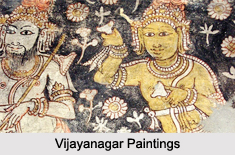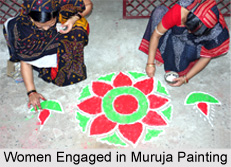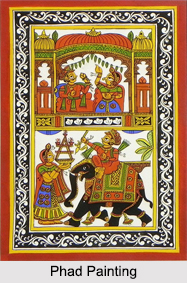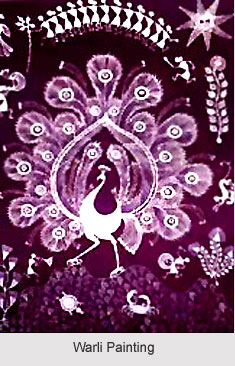 The paintings of the Vijayanagar represent the great revival of Hindu religion and art in South India.
In most of the Vijayanagar paintings, human faces usually appear in the profile and the figures stand with a slight slant with both feet pointing in the same direction. All these paintings are seen mainly on the ceilings of the mandapas and in the corridors of the temple. But unfortunately, most of them have become damaged now. Some of these Vijayanagar paintings depict the scenes related to Draupadi`s wedding and Kiratarjunya (Arjuna`s penance). Few other pictures show Viruppanna and Viranna with their sons and guards. They are shown wearing long white robes with a printed cloth round their waist.
The paintings of the Vijayanagar represent the great revival of Hindu religion and art in South India.
In most of the Vijayanagar paintings, human faces usually appear in the profile and the figures stand with a slight slant with both feet pointing in the same direction. All these paintings are seen mainly on the ceilings of the mandapas and in the corridors of the temple. But unfortunately, most of them have become damaged now. Some of these Vijayanagar paintings depict the scenes related to Draupadi`s wedding and Kiratarjunya (Arjuna`s penance). Few other pictures show Viruppanna and Viranna with their sons and guards. They are shown wearing long white robes with a printed cloth round their waist.
Vijayanagar Paintings in South Indian Temples
Some of the South Indian Temples are known to be adorned with Vijayanagar paintings. They are the Veerabhadra Temple, Virupaksha Temple and Kalyana Sundareswara Temple.
Vijayanagar Paintings in Veerabhadra Temple
During the Vijayanagar Empire mural paintings made a comeback post chalukya"s intense interest in mural paintings at Badami. The best representation of these paintings can be seen in the Veerabhadra temple in Lepakshi in Andhra Pradesh. In this temple, the Vijayanagar paintings are very decorative in style. A noteworthy aspect of the temple is the ceiling of its hall. It is the this ceiling which is adorned with mural paintings illustrating the scenes from the epics like the Mahabharata, the Ramayana and the Puranas and the life sketches of the benefactors of the temple. The Vijayanagara pictorial art is evident in the paintings in each bay on the ceiling of the main mandapa, the antarala and other shrines. They are painted over an initial plaster layer of lime mortar. Vegetable and mineral colors of yellow, ochre, black, blue and green blended with lime water have been used for painting. Red color is generally evident in the background of the paintings. The frescoes illustrate the incarnations of Lord Vishnu. Fresco is a painting rapidly completed with water color on wet plaster on a wall or ceiling. This is done so that the colors penetrate the plaster and become fixed as it dries. The paintings are in striking compositions where the particular emphasis is on the costumes of the period and facial expressions.
Vijayanagar Paintings in Virupaksha Temple
The Vijayanagar paintings have covered the ceiling of the great Virupaksha temple at Hampi and the themes of them are generally religious. There is simplicity and vigor in the style of the paintings with a sense of movement and energy caught in the figures, which represent a linear style. The ceiling of the Virupaksha temple mandapa has a painting, which depicts Vidyaranya, the guru of Harihara and Bukka and the founders of the Vijayanagar Empire being carried in a palanquin. These paintings show a rhythmic forward movement and do not look overcrowded. They also show the episodes from the life of the King Manunitikanda Chola, who granted justice to a cow whose calf was run over by his son`s chariot. In these paintings the king is shown sacrificing the prince under the chariot`s wheels, but Lord Siva is restoring life of both the victims and praising the king`s sense of justice. Most of these Vijayanagar paintings depict the mythological legends of Siva and stories from the epics but they also represent the life and customs of the Vijayanagar Empire.
Vijayanagar Paintings in Kalyana Sundareswara Temple
Apart from the temples mentioned above, the Kalyana Sundareswara temple in the Nallur village of the district of Tiruvarur also has paintings belonging to the Vijayanagara period. More specifically, these paintings have been discovered recently in the sanctum sanctorum of the temple. They are considered to be rare paintings of the said period and have been estimated to be created between the 15th and 16th centuries. The renovation work in this temple was executed prior to the Maha Kumbabisekam of the temple scheduled to be held on 30th of August. It is during this renovation work that this masterpiece surfaced itself. Kudvayil Balasubramanian, who is identified as a historian and archaeologist intimated about the discovery of these rare paintings. He came to the temple and studied them and many facts were consequently revealed about the identity of the paintings. It was revealed that the paintings were actually made during the rule of the Vijayanagara kings. The paintings illustrate Narada who plays a veena, an artist who keeps a pair of cymbals and a child called Skanda holding a lotus flower. The paintings were made using natural colors. Kudvayil Balasubramanian requested the authorities to protect these paintings as they provide insight into the history of paintings in Tamil Nadu.
Related Articles:
Indian Paintings
Paintings in South India
Types of Indian Painting
Traditional Indian Painting
Indian Folk Painting





